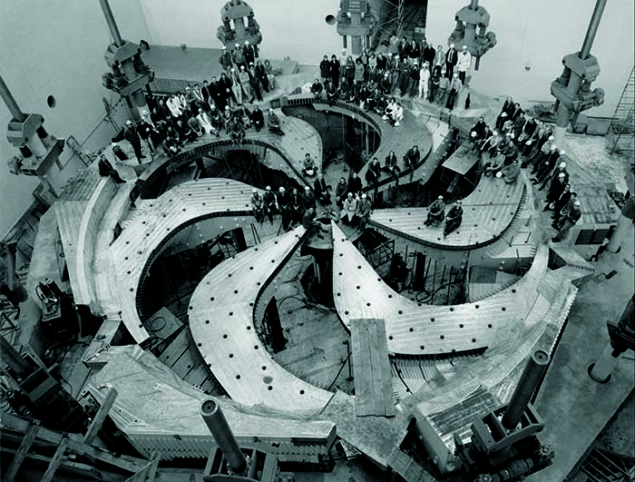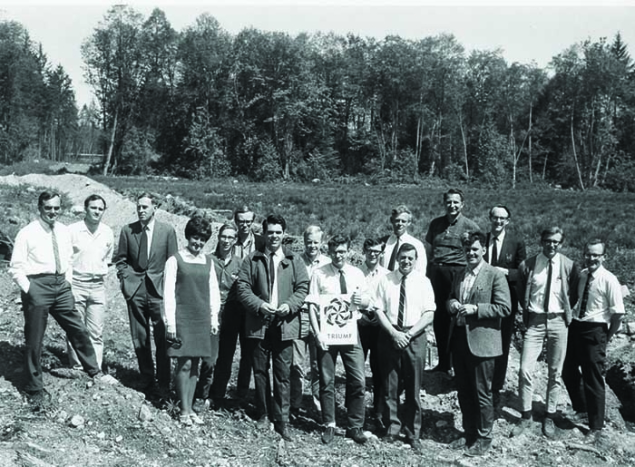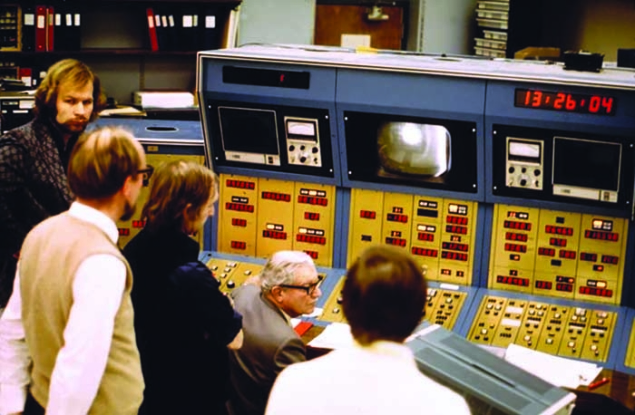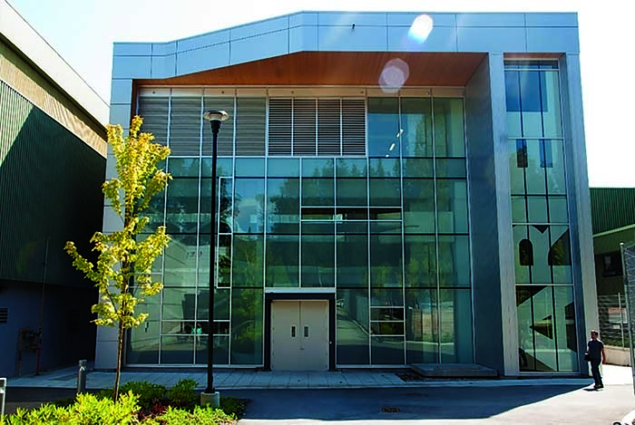Founded 50 years ago to meet research needs that no single university could provide,
Canada’s premier accelerator laboratory continues to drive discoveries.

The TRIUMF laboratory’s 50-year legacy is imprinted on its 13-acre campus in Vancouver; decades-old buildings of cinderblock and corrugated steel sit alongside new facilities housing state-of-the-art equipment. With each new facility, the lab continues its half-century journey from a regional tri-university meson facility (from where the acronym TRIUMF comes) to a national and international hub for science.
At the laboratory’s centre is the original 520 MeV cyclotron, a negative-hydrogen-ion accelerator so well engineered when it was first built that it continues to function (albeit with updated controls and electronics) as TRIUMF’s heart. Over the past 50 years, the TRIUMF cyclotron has spurred the growth of a diverse and multidisciplinary community whose ideas continue to coax new uses from the decades-old accelerator. These new applications serve to continuously redefine TRIUMF as an institution: a superconducting linear accelerator that complements the original cyclotron; 17 universities and counting that have joined the original trio; and an expanding network of collaborators that now spans the globe.

TRIUMF, which began with a daring idea and a simple patch of rainforest on the University of British Columbia’s (UBC) south campus, is this year reflecting on its rich past, its vibrant present and the promise of a bright future.
The tri-university meson facility
The first inklings for the tri-university meson facility were themselves a product of three separate elements: a trio of Canadian universities, a novel accelerator concept and an appetite for collaboration within the field of nuclear physics in the early 1960s. And the researchers involved were well positioned to develop such a proposal. John Warren, at that time head of the nuclear-physics group at UBC, had established a team of remarkable graduate students while constructing a 3 MeV Van de Graaff accelerator. Erich Vogt had just transitioned to the UBC physics faculty from an illustrious career as a theoretical nuclear physicist at the Chalk River Laboratory in Ontario. And finally, J Reginald Richardson, a Canadian-born physicist at the University of California in Los Angeles (UCLA), who had finalised a concept for a sector-focused, spiral-ridge negative-hydrogen-ion cyclotron – many of the ideas for which came while holidaying at his cottage on Galiano Island on the West Coast of British Columbia. In the years that followed, all three of them would go on to become a director of TRIUMF.

At the time, the world was ready to dig deeper into nuclear structure and explore other hadronic mysteries using powerful meson beams. This push for “meson factories” led to LAMPF in the US, SIN (now PSI) in Switzerland and, eventually, TRIUMF in Vancouver.
In 1964, a young physicist named Michael Craddock (who would become a long-time CERN Courier contributor) completed his PhD in nuclear physics at the University of Oxford in the UK before joining the UBC physics faculty. In June 1965, Craddock attended a meeting between representatives of UBC, the University of Victoria and Simon Fraser University, and wrote a summary of the proceedings: an agreement to develop a proposal for a tri-university meson facility based on the Richardson negative-hydrogen-ion cyclotron. Not three years later, in April 1968, the group received $19 million CDN in federal funding and construction began.

Warren presided as TRIUMF’s first director, and many of the accelerator’s build team came from his Van de Graaff graduate students. The initial organisation consisted of a university faculty member directing the engineers and consultants responsible for each of the main components of the cyclotron: its ion source, radio-frequency, magnet and vacuum systems. Joop Burgerjon, the engineer for the construction of the 50 MeV negative-hydrogen-ion cyclotron at the University of Manitoba, which was itself a copy of the 50 MeV UCLA cyclotron, became the chief engineer for TRIUMF.
Ewart Blackmore (one of this article’s authors) was one of Warren’s graduate students who was brought back to work on the accelerator design and construction. In 1968, while working as a postdoctoral fellow at what is now the Rutherford Appleton Laboratory, in the UK, Blackmore and another postdoctoral fellow, David Axen (also a former UBC graduate student) received a call to coordinate an experiment to measure the dissociation rate of negative hydrogen ions in a magnetic field. This is an important parameter for setting the maximum magnetic field of the cyclotron. The measurement used the proton linear accelerator at the Rutherford laboratory and resulted in a higher dissociation rate than expected from earlier experiments, increasing the size of the cyclotron by 4%.

Upon his return to Vancouver, Blackmore shouldered the responsibility for the cyclotron’s injection, beam diagnostics and extraction systems. All of these components and more were put to the test with a full-scale model of the cyclotron’s centre core, which achieved first beam in 1972. Finally, despite a six-month delay to reshape the magnetic field produced by the 4000 tonne magnet, the TRIUMF team of about 160 physicists, engineers and technical staff coaxed a beam of protons from the cyclotron on 15 December 1974. TRIUMF’s scientific programme began the following year with an initial complement of experimental beamlines: proton, neutron, pion and muon. In the end, the project was on budget and very near the original schedule. The machine reached its design current of 100 μA in 1977, with Blackmore coordinating the first five years of commissioning and operations. He recalls that it was a remarkable experience to witness the moment first beam was achieved from the cyclotron. “At the start of it all, most of us had little understanding of cyclotrons and related technologies, but we had the valuable experience we had gained as graduate students.”
International physics hub
The story of TRIUMF quickly developed, the lab reinventing itself time and again to keep up with the fast pace at which the field was evolving. By the early 1980s, TRIUMF was a well-established accelerator laboratory that operated the world’s largest cyclotron. In those days, TRIUMF utilised proton and neutron beams to drive a powerful research programme in nucleon–nucleon/nucleus interaction studies, muon beams for muon-spin-rotation experiments in material sciences, pion beams for nuclear-structure studies, and meson beams for precision electroweak experiments.
However, as the field advanced, new discoveries in meson science were changing the landscape. TRIUMF responded by proposing an even-larger accelerator system, the 30 GeV KAON (Kaons, Antiprotons, Other hadrons and Neutrinos) complex. When fully complete, KAON would have allowed cutting-edge high-energy-physics experiments at the intensity frontier. It was a bold proposal that garnered substantial national and international interest but ultimately did not find enough political support to be funded. Nevertheless, the concept itself was considered visionary, and the science that TRIUMF wanted to enact was taken up decades later in modified forms at the J-PARC complex in Japan and the upcoming FAIR facility in Germany (CERN Courier July/August 2017 p41).

The loss of KAON forced an existential crisis on TRIUMF, and the laboratory responded in two parallel directions. Firstly, TRIUMF expanded Canada’s contributions to international physics collaborations. During the decade-long campaign to design KAON, TRIUMF had developed an impressive array of scientific and engineering talent and capabilities in the design of accelerators, production targets and detectors. This enabled the Canadian physics community – supported by TRIUMF – to contribute to CERN’s Large Hadron Collider (LHC) and join the ATLAS collaboration, building components such as the warm twin-aperture quadrupoles for the LHC and the hadronic endcap calorimeter for ATLAS. This positioned TRIUMF as Canada’s gateway to international subatomic physics and paved the way for Canada’s contributions to other major physics collaborations like T2K in Japan.
The laboratory’s second response to the loss of KAON was the development at TRIUMF of a new scientific programme centred on rare isotopes. By the 1980s, the field of rare isotopes had become of burgeoning interest, opening new avenues of research for TRIUMF into nuclear astrophysics, fundamental nuclear physics and low-energy precision probes of subatomic symmetries. TRIUMF had recognised the worldwide shortage of isotope production facilities and understood the role it could play in rectifying the situation. The lab already possessed expertise in beam and target physics, design and engineering — and, since its inception, a high-powered 520 MeV cyclotron that could act as a beam driver for producing exotic isotopes.
Rare-isotope beams at TRIUMF started during the KAON era with the small TISOL (Test facility of Isotope Separation On-Line) project in 1987, which used an isotope-separation concept developed at CERN’s ISOLDE facility. Experience at TISOL gave its proponents confidence that a much-larger-scale rare-isotope-beams facility could be built at TRIUMF. And so the Isotope Separator and Accelerator (ISAC) era was born at TRIUMF. Today, TRIUMF’s ISAC boasts the highest production power of any ISOL-type facility and some of the highest rates of rare-isotope production in the world. ISAC enables TRIUMF to produce isotopes for a variety of research areas, including studies of the formation of the heavy chemical elements in the universe, exploration of phenomena beyond the Standard Model of particle physics and inquiry into the deepest secrets of the atomic nucleus. In addition, spin-polarised beta-emitting isotopes produced at TRIUMF make possible detailed probes for surface and interface studies in complex quantum materials or novel batteries, benefiting the molecular- and materials-science communities.

TRIUMF is continuing to build on its expertise and capabilities in isotope science by adding new rare-isotope production facilities to supply the laboratory’s existing experimental stations. A new project, ARIEL (the Advanced Rare Isotope Laboratory), will add two rare-isotope production stations driven by a new proton beamline from the cyclotron and a new electron beamline from a new superconducting linear accelerator (designed and built in Canada). ARIEL will triple the output of the science programme based on rare-isotope beams, creating new opportunities for innovation and allowing the lab to branch off into promising new areas, even outside of subatomic physics, materials science and nuclear astrophysics. Although ARIEL’s completion date is set for 2023, the facility’s multi-stage installation will allow the TRIUMF community to begin scientific operations as early as 2019.
An innovation lab
TRIUMF’s history is defined not only by a drive to push the frontiers of science and discovery, but also those of innovation. The flexibility of the iconic cyclotron at the heart of TRIUMF’s scientific programme has allowed the lab to venture into areas that few could have imagined at the time of its original proposal. Standing on the shoulders of its founders, TRIUMF’s community now turns to the next half-century and beyond, and asks: how can TRIUMF increase its impact on our everyday lives?
While fundamental research remains core to TRIUMF’s mission, the laboratory has long appreciated the necessity and opportunity for translating its technologies to the benefit of society. TRIUMF Innovations, the lab’s commercialisation arm, actively targets and develops new opportunities for collaboration and company creation surrounding the physics-based technologies that emerge from the TRIUMF network.
Perhaps the most long-standing of these collaborations is TRIUMF’s more than 30-year partnership with the global health-science company Nordion. A team of TRIUMF scientists, engineers and technicians works with Nordion to operate TRIUMF cyclotrons to produce commercial medical isotopes that are used in diagnosing cancer and cardiac conditions. During the course of this partnership, more than 50 million patient doses of medical isotopes have been produced at TRIUMF and delivered to patients around the world.
Another outcome of TRIUMF Innovations is ARTMS Products Inc, which produces cyclotron-target technology enabling cleaner and greener manufacturing of medical isotopes within local hospitals. ARTMS has already secured venture-capital funding and multiple successful installations are under way around the world. Its technology for producing the most commonly used medical isotope, technetium-99, will help stabilise the global isotope supply chain in the wake of the shutdown of the Chalk River reactor facility.
TRIUMF Innovations will play a key role in fostering industry relationships enabled by the future Institute for Advanced Medical Isotopes (IAMI), a critical piece of infrastructure that will advance nuclear medicine in Canada. Supported by TRIUMF’s life sciences division, IAMI will provide infrastructure and expertise towards developing new diagnostics and radiotherapies. IAMI will also provide industry partners with facilities to study and test new isotopes and radiopharmaceuticals that hold great promise for improving the health of patients in Canada and around the world.
Similarly, TRIUMF and TRIUMF Innovations are also working to support the emerging field of targeted alpha-emitting therapeutics — radiotherapy medicines that hold new promise for patients who have been diagnosed with advanced and life-threatening metastasised cancers. Multiple new companies are currently developing novel treatments, but all are hampered by a global shortage of actinium-225 (225Ac), a hard-to-produce isotope at the core of many of these therapies. The TRIUMF cyclotron is unmatched in 225Ac production capacity, and the laboratory is working with researchers and industry partners to bring this production online and to speed up the development of new therapies with the potential to offer new hope to patients with cancers that are currently deemed incurable.
Beyond these developments, TRIUMF Innovations manages a portfolio of TRIUMF products and services that range from providing irradiation services for stress-testing communications and aerospace technologies to improving the efficacy and safety of mining exploration using muon detectors to help geologists estimate the size and location of ore deposits.
In the coming years, TRIUMF Innovations will continue to advance commercialisation both within TRIUMF and through TRIUMF’s networks. For example, TRIUMF is now seeking to develop a new data-science hub to connect its 20 member universities and global research partners to private-sector training opportunities and new quantum-computing tools. Drawing on data-science acumen developed through the ATLAS collaboration, TRIUMF is building industry partnerships that train academic researchers to use their data-science skills in the private sector and connect them with new research and career opportunities.
It is clear that TRIUMF’s sustained focus on commercialisation and collaboration will ensure that the lab continues to bring the benefits of accelerator-based science into society and to pursue world-leading science with impact.
The quest continues
Fifty years in, TRIUMF’s narrative is a continuous work in progress, a story unfolding beneath the mossy boughs of the same fir and alder trees that looked down on the first shovel strike, the first sheet of concrete, the first summer barbecue. In the coming years, the lab will continue to welcome fresh faces, to upgrade and add new facilities, to broach new frontiers, and to confront new challenges. It is difficult to predict exactly where the next era of TRIUMF will lead, but if there is one thing we can be sure of, it is that TRIUMF’s community of discoverers and innovators will be exploring ideas and seeking out new frontiers for years to come.








